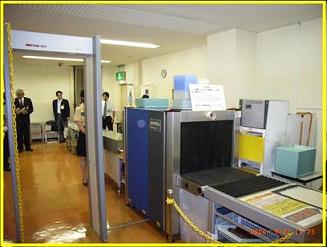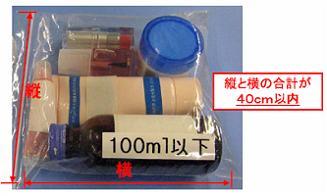 |
|
 |
 |
 |
Since the terrorist attacks on September 11th, the international community has been faced with the harsh reality in the filed of aviation security and is combating continually emerging threats against civil aviation. While playing active role in ICAO's aviation security activities, Japan has developed various kinds of aviation security measures to address these emerging threats in accordance with the ICAO international standards and in cooperation with the international community. |
| |
Recent topic
|
 |
New aviation security rules of cabin baggage have been applied to international passenger flights departing from airports in Japan since 1st March 2007. These measures are to address emerging threats of liquid explosives raised in a terrorist plot revealed in the U.K. on August 2006. The CAB has produced videos, posters and leaflets to make these new rules known to the people.
1.Announcement
2.Video
3.Poster
4.Leaflet (Single-side printing, Double-side printing)
|
 |
Aviation Security Systems in Japan
|
 |
Various kinds of aviation security measures are being implemented in Japan. The government, air carriers, airport operators and other organizations concerned play their respective roles in their implementation. Air carriers screen passengers and baggage, and take security measures for air cargo. Airport operators, responsible for maintaining order in airports, conduct access control to the airside and security restricted areas, |
 |
 |
establish security contingency plans and drill for tackling acts of unlawful interference. The Civil Aviation Bureau (CAB) of the Ministry of Land, Infrastructure and Transport (MLIT) as the competent authority in aviation security, sets the standards for security measures to be implemented by air carriers, airport operators and other organizations concerned, supervises them by |
 |
 |
inspecting overall security systems in airports, including passenger and baggage screening, and also provides training for security personnel in the aviation industry.
|
| Introduction of the In-line screening system |
|
|
 |
 |
Reinforcement of aviation security measures after the terrorist attack in the US
The Japanese government raised the national security standard to the highest level immediately after the September 11 terrorist attacks, followed by developing new security standards in accordance with the international standards to require further enhanced measures for aviation security. Based on these enhanced security standards, installation of advance screening equipment such as new explosive detection systems have been introduced to address more elaborate methods of hijacking and terrorist acts. These countermeasures inevitably increases the cost for aviation security. The CAB has secured the budget of over 8 billion yen in the 2007 fiscal year for aviation security.
The CAB is thus carrying out its grave responsibility for aviation security by establishing security standards, supervising the security measures based on these standards and by securing the budget for aviation security activities. Concrete measures taken after the terrorist attacks in the US are as follows:
|
 |
 |
| 1. Precautions against hijacking |
| To prevent hijacking, terrorism and other acts of unlawful interference |
- The level of airport alert practiced by airline companies has been raised to the highest and airport security practiced by airport managers was thoroughly implemented immediately after the terrorist attacks in the US.
- The regulation against taking dangerous goods on board the aircrafts of both domestic and international flights has been reinforced by including items such as small knives and scissors in the prohibited item list.
- Since January 2006, screening system for airport officials and other workers has been introduced.
- Certain aircrafts have been required to be equipped with enhanced cockpit doors to prevent the intrusion of hijackers into the cockpit.
- The cockpit doors now have to be provided with improved bulletproof and shockproof functions.
- Sky Marshall program has been introduced since December 2004.
|
 |
| 2. Precautions against terrorism using light planes |
- The CAB has called on light plane operators to refrain from flying over the US military facilities in Japan and issued aeronautical information (NOTAM).
- The CAB has also instructed to conduct body search inspections when carrying unfamiliar persons to prevent the taking of dangerous goods onto aircrafts, and to thoroughly check aircraft bodies and crop dusting devices.
- More stringent checks for suspicious persons when receiving the flight plans for small airplanes have been introduced.
|
 |
| 3. Countermeasures against actual incidents |
- Information gathering and direction transmission have been improved by utilizing the airport crisis management information system, which can transmit live images of the airport.
- Manuals for the quick and safe landing of flying aircraft at the nearest airport in case of emergency have been prepared.
- It has been stipulated that refraining from flying in certain airspace can be requested and aeronautical information (NOTAM) will be issued as the need arises.
|
|
 |
 |
|












